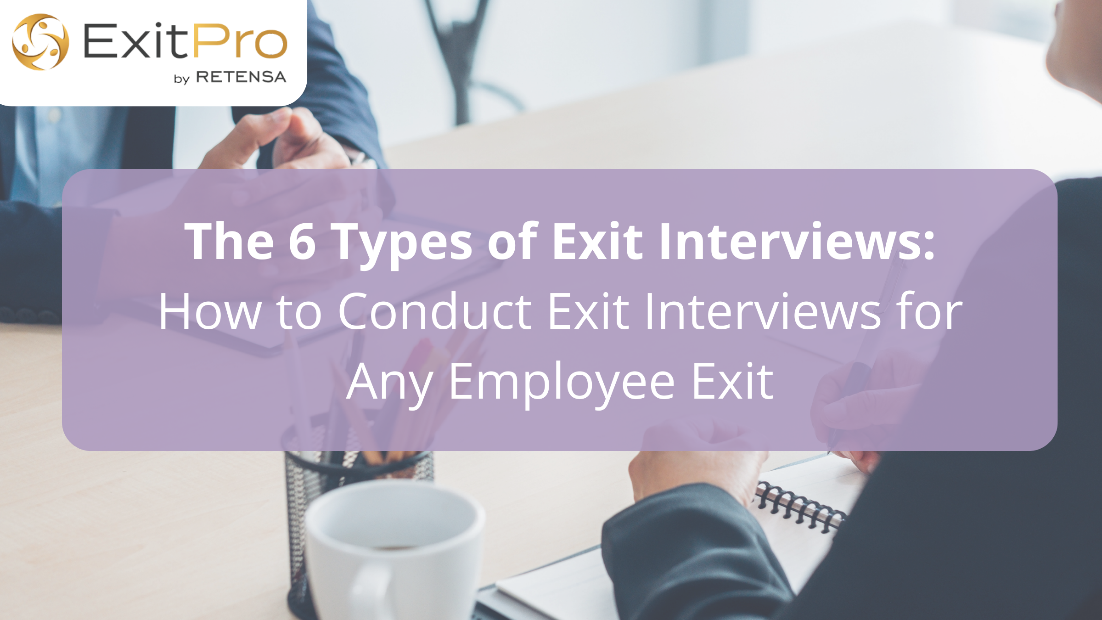Why Exit Interview Programs Fail
Let’s start with the bad news. More than half of current exit interview programs do NOT deliver “meaningful” results. Below are the three most common reasons exit interview programs fail:
- Too hard to consistently send/manage/collect
- Low exit survey completion rates
- Did not produce useful/actionable information
When Should You Conduct Employee Exit Interviews?
An effective exit interview process:
- Generates positive change
- Requires multiple exit survey tools to understand the state of a workforce
- Focuses attention on the areas the employees can influence, instead of areas outside of their control
Creating and implementing more effective exit interviews may seem challenging and time-consuming. There is a lot of noise from exit survey results, so leaders must focus their attention on what matters to influence meaningful organizational change. Understanding the connection between employee feedback, behavior, and trends will prioritize organizational recommendations faster.
When you can, invite separating employees to conduct an exit interview before their last day. Retensa’s employee retention experts found that completion rates are 20-30% higher the week before an employee separates rather than after.
The best exit interview questions are actionable and cover five (5) key areas:
- Reasons they like working there (culture, salary/benefits, responsibilities)
- Reasons they are leaving (salary/benefits, management, other opportunity)
- Recommendations for improvement
- Employer-employee relationship
- Ethical/Legal concerns
How to Deliver the Best Exit Interview Program
Now, the good news! There are many ways to effectively deploy an exit interview process. In general, it’s important to give employees a safe space to express their true opinions. This influences them to give the most honest exit interview feedback, provides them with closure, and increases the chances they’ll depart on good terms. The best exit survey results come from separating employees who feel comfortable expressing how they feel, and trust those they are speaking with to listen confidentially.
Outsourcing Exit Interviews for Comfort and Honesty
One way to achieve this comfort and honesty among employee feedback is outsourcing exit interviews. Since most employees don’t want to burn bridges, using a third party relieves them from holding back their opinions. A good third-party exit interview consultant trains interviewers so employees feel comfortable to open up and answer more questions during the exit interview process.
Turnover Toolkit: Cost of Employee Turnover Checklist
Automating the Exit Interview Process
There are also exit interview companies that automate the whole program – from exit survey tools to turnkey reports. They streamline and simplify the process to ensure it’s easy and consistent. Some can also provide turnover analysis and survey interpretation to highlight the most actionable information based on results from strong exit interview questions.
What to do with Exit Interview Findings
An exit interview provides a truthful evaluation of the work environment and organizational culture. Responses from exit interview reports can often spark change initiatives in a number of areas, including:
- Recruiting/talent acquisition
- Onboarding/orientation
- Staff development
- Manager training courses
- Work-life balance
- Compensation (base pay and/or bonus)
When several employees provide similar responses, it’s time to act. Implementing change based on exit surveys shows current employees that leadership listens and values their input, boosting morale. This is why 92% of mid-size and large companies conduct exit surveys for at least some separating employees. For the biggest wins, target improvements that address the top 5 reasons for leaving.
By focusing on meaningful change, exit interview data can align retention strategies with company culture. This inspires employees to remain engaged and motivated. With collective feedback, employers can prioritize changes that improve the work environment for the most impacted employees, supporting loyalty and reducing turnover.feedback, employers can prioritize changes that improve the work environment for the most impacted employees, supporting loyalty and reducing turnover.
While many exit interview programs fail, using the right questions and strategies can yield honest, targeted insights that enhance employee retention long-term.
Frequently Asked Questions
- 1. How should HR handle negative feedback from exit interviews?
Handle negative feedback constructively by separating critiques from insights. Review feedback objectively, identify themes, and share findings with senior management confidentially to inform improvements.
- 2. What metrics should be used to measure the success of an exit interview program?
- Turnover Rate: Monitor v
o luntary turnover. - Retention of High Performers: Check top talent retention.
- Constructive themes: Spot recurring issues.
- Engagement Scores:
Comp ar e pr e– and pos t-surve ys . - eNPS (Employee Net Promoter Score): Gauge employee loyalty by asking how likely they are to recommend the company as a workplace.
- 3. What is the best method for conducting exit interviews?
Choose methods matching your culture and resources. Voice-based interviews offer valuable depth and the opportunity for wider feedback, especially when conducted by third-party interviewers to ensure neutrality. Standardizing the process will help maintain consistency.
- 4. How often should exit interview data be reviewed?
Review quarterly to identify patterns. Increase frequency during high turnover or after major changes. Regular reviews demonstrate feedback is valued.
- 5. Should exit interviews be mandatory?
Voluntary participation is preferred to avoid resentment. Encourage involvement by presenting it as valuable and confidential. Highlight the company’s commitment and offer incentives.
- 6. How should HR ensure the information collected from exit interviews leads to real change?
- Implement a followup plan: share findings with management, create action plans, and establish a feedback loop to show employees their input matters. Communicate these findings to employees to strengthen trust in future surveys.
- 7. Can exit interviews improve retention rates?
Exit interviews don’t directly reduce turnover but provide insights and show employees their feedback matters, fostering loyalty, and boosting retention.
Exit Interview Template
For a comprehensive exit interview form, use the template available at ExitPro Exit Interview Forms. This template provides a structured approach to collecting detailed feedback from departing employees.
Exit Interview Resources:
1. Everett Spain, Boris Groysberg. (2016, April). Making Exit Interviews Count. Retrieved from Harvard Business Review: https://hbr.org/2016/04/making-exit-interviews-count
2. Retensa. (n.d.). Blog. Retrieved from Build the Perfect Exit Interview, Build a Better Workplace: https://retensa.com/blog/build-the-perfect-exit-interview-build-a-better-workplace/
3. Retensa. (n.d.). Exit Interview Research Study: Advanced Analysis Report: https://store.exitpro.com/product/exit-interview-research-study-advanced-analysis-report/
4. Pushfar. (n.d.). The ultimate guide to employee exit interviews: A template for new exit interview programs. Pushfar. Available at: https://www.pushfar.com/article/the-ultimate-guide-to-employee-exit-interviews-a-template-for-new-exit-interview-programs/
5. Peeling, A. (2024, June 21). 12 Exit Interview Questions Every HR Professional Should Ask. Retrieved from https://www.shrm.org/topics-tools/news/talent-acquisition/best-exit-interview-questions.
6. Thomson Reuters. (n.d.). Are You Conducting Proper Exit Interviews? Retrieved from https://legal.thomsonreuters.com/en/insights/articles/are-you-conducting-proper-exit-interviews#:~:text=An%20exit%20interview%20is%20a,or%20last%20day%20of%20work.
7. SHRM. (n.d.). Exit Interview Questions. Retrieved from https://www.shrm.org/topics-tools/tools/forms/exit-interview-questions.




